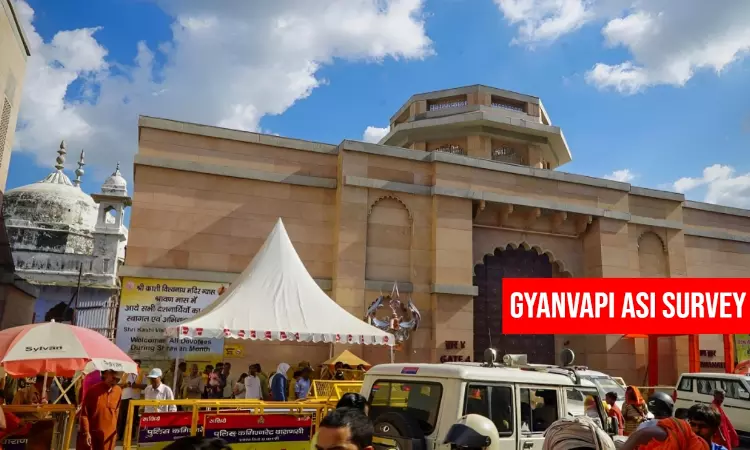- Home
- /
- News Updates
- /
- Plea In Varanasi Court Seeks...
Plea In Varanasi Court Seeks Direction To ASI To Determine If Gyanvapi Mosque Was Built Upon A Hindu Temple; Ascertain True Nature Of 'Shiva Linga'
Sparsh Upadhyay
11 Feb 2024 9:22 AM
A fresh application has been moved before a Varanasi fast-track court seeking an ASI survey of the entire Gyanvapi mosque area, including the wuzukhana and closed cellars under three domes and determine if the Mosque was built/super-imposed upon a Hindu Temple. This application has been moved by Advocate Vijay Shankar Rastogi, the next friend of Swayambhu Adi Vishweshwara (deity)...
A fresh application has been moved before a Varanasi fast-track court seeking an ASI survey of the entire Gyanvapi mosque area, including the wuzukhana and closed cellars under three domes and determine if the Mosque was built/super-imposed upon a Hindu Temple.
This application has been moved by Advocate Vijay Shankar Rastogi, the next friend of Swayambhu Adi Vishweshwara (deity) in the suit filed by Rastogi himself in 1991 (on behalf of the deity) claiming the Muslim community had illegally occupied the disputed property (where Gyanvapi Mosque stands right now).
For context, in the 1991 suit, an order has been sought to declare the structure as the property of Lord Visheshwara and devotees and to direct the defendants to remove their structure and hand over the possession of the property to the plaintiffs.
The application refers to the Varanasi Court's April 2021 order directing the Archaeological Survey of India to survey the disputed site of Kashi Vishwanath Temple-Gyanvapi Mosque. Notably, the Court, inter alia, primarily issued the following directions to the ASI:
- whether the religious structure standing at present at the disputed site is a superimposition, alteration or addition or there is structural overlapping of any kind, with or over, any other religious structure.
- The committee shall also trace as to whether any temple belonging to the Hindu community ever existed before the mosque in question was built or superimposed or added upon it at the disputed site.
- If so, then what exactly is the age, size, monumental and architectural design or style of the same, and also, as to which of the Hindu deity or deities the same was devoted to?
In effect, this order was later modified by the Allahabad High Court in December 2023 wherein it held that the 1991 suit is not barred by the Places of Worship Act 1991.
With this, the High Court REJECTED the pleas filed by Anjuman Intezamia Masajid Committee challenging primarily year 1991 suit concerning the Gyanvapi title dispute. The Court added that Masjid compound can have either a Mulsim character or a Hindu character and the same can not be decided at the stage of framing issues.
Importantly, the Court had directed the ASI to place its report of a scientific survey [done in Original Suit No.18 of 2022 (693 of 2021)], in Suit No.610 of 1991 also, which shall be taken into consideration by the court.
Against this backdrop, the plea states that the ASI's report submitted last year (in compliance with Varanasi Court's order passed in a different Suit of 2022) is incomplete if seen in the light of the Varanasi court's order in April 2021 and hence, necessary directions are required to be passed.
“…it is necessary and expedient in the interest of justice to direct the Director General, Archaeological Survey of India…to make a scientific survey, according to the science of archaeology by the Ground Penetrating Radar (GPR) and Geo-Radiology System and by Excavation or extraction work…on the point mentioned in this application in accordance with the order dated 8.04.2021 and modified by the Allahabad HC…,” the plea states.
Further, the plea seeks direction to the ASI to survey the premises on the following additional points (list not exhaustive):
- To get a comprehensive archaeological physical survey of the Entire disputed area
- To record its finding to the effect as to whether the true architectural structure traced at the disputed site has any sort of connection with the Temples and Artefacts
- Inspect and survey the part of the disputed structure from the Ground level and upper floor over and above the Cellars, where the Shivlinga has been recovered during the Commissioner inspection and to report about the fact that the recovered image is of the "Shivalinga" or the "Fountain" in its true structure.
- To survey the entire cellars beneath the disputed structure by removing the newly raised and constructed brick walls mainly beneath the Central Chamber (Dome) of the disputed structure to find out as to whether there exists the main Swayambhu Jyotirlinga and its Argha or not without any harm to the disputed structure
- Whether the Religious structure standing at present at the disputed site is a superimposition, alteration or addition or there is structural overlapping of any kind, with or over, any religious structure, if so then what exactly is the age, size, monumental and archaeological design or style of the religious structure standing at present at the disputed site and what materials have been used for building the same.
- Whether any temple belonging to the Hindu Community ever existed before the alleged structure of the Mosque in question was built or superimposed or added upon it at the disputed site, if so, then what exactly is the age, size, monumental and archaeological design or style of the same and also, as to which of the Hindu deity or deities the same was devoted to.
- To enter into every portion of the Religious structure standing at present at the disputed site and to resort to Firstly, through Ground Penetrating Radar (GPR) or Geo-Redcology System or both, to satisfy itself as to whether any excavation or extraction work is needed at any portion of the religious structure standing at present.

